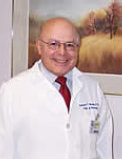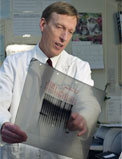A Reflection on the Increasing Importance of Private Capital in Medical Research
Wednesday, October 15, 2014
Private philanthropic foundations are emerging as a revolutionary source of innovative medical research and development funds. Though the amount of private philanthropic donations as a percentage of medical research spending, is still at a nascent stage, the reality of stagnating federal and state contributions to research and development enterprises is indicative of the future impact that private dollars may have on the field.
Funding for a disease is often scarce when the condition only affects a small portion of the population, or is considered to be less severe than other diseases in its class. Philanthropic medical research donations can target and drive medical advancements in these fields or with these diseases which are relatively neglected.
For example, Michael Goldberg, founding partner at the personal injury law firm Goldberg Weisman Cairo, and his family started the Goldberg Nathan Myotonic Dystrophy Type 2 Fund to encourage medical research into myotonic dystrophy type 2 (a rare genetic disorder characterized by muscular dystrophy).
The Goldberg endowment donated $1.25 million gift to the University of Rochester School of Medicine and Dentistry. The gift will be used to establish a center that will specifically study myotonic dystrophy type 2. Donations from private individuals who have loved ones or family members afflicted with rare genetic conditions are invaluable.
Moxley and Thornton Honored for Myotonic Dystrophy Research
Monday, September 22, 2014
University of Rochester neurologists Richard Moxley, M.D., and Charles Thornton, M.D., have been recognized by the Myotonic Dystrophy Foundation (MDF) with an Outstanding Research Achievement Award. The event took place at the U.S. Capitol earlier this month and honored their contribution to finding new treatments for myotonic dystrophy.
"This award is in recognition of the enduring and transformative collaboration that Drs. Moxley and Thornton have carried out in myotonic dystrophy research and clinical care, and the truly outstanding progress they have made possible in the search for treatments and a cure for the disease," said Molly White, executive director of MDF.
This recognition follows on the heels of a $7 million grant from the National Institute of Neurological Disorders and Stroke (NINDS) to renew funding for the University's Senator Paul D. Wellstone Muscular Dystrophy Cooperative Research Center, a designation that dates back to 2003. The team is also preparing -- in collaboration with Isis Pharmaceuticals -- to begin testing the first targeted treatment for the disease.
This research has brought scientists to the threshold of a potential new therapy that could reverse the genetic cause of DM1. Partnering with Isis Pharmaceuticals, the Rochester team developed a synthetic molecule -- called an antisense oligonucleotide -- that mimics a segment of the genetic code. In a study appearing in the journal Nature in 2012, Thornton and his colleagues showed that, when injected into mice with myotonic dystrophy, these molecules improved function. Isis Pharmaceuticals has recently completed Phase 1 testing and will soon advance to testing in people with the disease.
Gift Will Advance Research on Myotonic Dystrophy Type 2
Tuesday, September 9, 2014
A $1.25 million gift from Lilyan (Lil) and Albert (Alfy) Nathan of Florida and Michael and Sherry Goldberg of Chicago will create a new center dedicated to research on myotonic dystrophy type 2 (DM2) at the University of Rochester School of Medicine and Dentistry. The gift will be used to support a new research program that will be led by UR Medicine neurologist Chad Heatwole, M.D.
We are deeply grateful to the Nathan and Goldberg families for their extreme generosity,
said Robert Holloway, M.D., M.P.H., the chair of Department of Neurology and the Edward A. and Alma Vollertsen Rykenboer Chair in Neurophysiology. Due to the efforts of Chad Heatwole, Richard Moxley, Charles Thornton, and many others here in Rochester, we believe that new therapies for this disease are on the horizon. This gift will help accelerate these efforts.
Myotonic dystrophy has been characterized as one of the most diverse genetic diseases with a wide range of symptoms ranging from fatigue, muscle stiffness, muscle weakness, cognitive impairment, depression, difficulty sleeping, impaired vision, pain, difficulty swallowing, and gastrointestinal problems. The severity and onset of these symptoms vary from patient to patient.
Dr. Heatwole gave us the first glimmer of hope that someone was actually interested in helping people with this disease,
said Michael Goldberg, founding partner of the Chicago firm Goldberg Weisman Cairo. While our family had never made a major donation to a charity or medical institution before, we believed in Dr. Heatwole, the University of Rochester, and in the importance of helping find a cure for DM2 for our son and for the untold number of other people afflicted with this disease.
A Promising Step Forward Toward Muscular Dystrophy Treatment
Wednesday, August 1, 2012
Deposits of toxic RNA (red) are seen here
inside muscle cell nuclei (blue) from an individual
with myotonic dystrophy.
Scientists have reversed symptoms of myotonic muscular dystrophy in mice by eliminating a buildup of toxic RNA in muscle cells. The work, carried out by scientists at the University of Rochester Medical Center, Isis Pharmaceuticals Inc. and Genzyme, is published in the August 2 issue of Nature.
After experimental antisense compounds were administered to mice twice a week for four weeks, symptoms of the disease were reduced for up to one year – a significant portion of a mouse's lifespan.
The investigators say that while the work is an encouraging step forward against myotonic dystrophy, one of the most common forms of muscular dystrophy, it's too soon to know whether the approach will work in patients. But they are cautiously optimistic, noting that the compound is extremely effective at reversing the disease – whose genetic underpinnings make it particularly vulnerable to an antisense approach – in a mouse model.
These results give us strong encouragement about the possibility of developing a treatment that could fundamentally alter the disease. It's an important step on a long path,
said senior author Charles Thornton, M.D., a neurologist at the University of Rochester Medical Center who has been pursuing new treatments for the disease for more than two decades.
In Muscular Dystrophy, What Matters to Patients and Doctors Can Differ
Wednesday, July 25, 2012
Complex, multi-system diseases like myotonic dystrophy -- the most common adult form of muscular dystrophy -- require physicians and patients to identify which symptoms impact quality of life and, consequently, what treatments should take priority. However, a new study out this month in the journal Neurology reveals that there is often a disconnect between the two groups over which symptoms are more important, a phenomenon that not only impacts care but also the direction of research into new therapies.
Some Muscular Dystrophy Patients at Increased Risk for Cancer
Tuesday, December 13, 2011
People who have the most common type of adult muscular dystrophy also have a higher risk of getting cancer, according to a paper published today in the Journal of the American Medical Association.
The team found that patients who have myotonic muscular dystrophy are at increased risk primarily for four types of cancer: brain, ovary, colon, and the uterine lining known as the endometrium. The team also found a possible increased risk for some other types of cancer, including cancer of the eye, thyroid, pancreas, and other female reproductive organs.
Physicians estimate that approximately 40,000 Americans have myotonic dystrophy, an inherited disease that is marked by progressive muscle weakness. While the course of the disease varies from patient to patient, symptoms can include muscle stiffness, difficulty speaking and swallowing, problems walking, and in some patients, heart problems and cataracts.
Genetic Source of Muscular Dystrophy Neutralized
Thursday, July 16, 2009
Researchers at the University of Rochester Medical Center have found a way to block the genetic flaw at the heart of a common form of muscular dystrophy. The results of the study, which were published today in the journal Science, could pave the way for new therapies that essentially reverse the symptoms of the disease.
The researchers used a synthetic molecule to break up deposits of toxic genetic material and re-establish the cellular activity that is disrupted by the disease. Because scientists believe that potentially all of the symptoms of myotonic dystrophy – the most common form of muscular dystrophy in adults – flow from this single genetic flaw, neutralizing it could potentially restore muscle function in people with the disease.
This study establishes a proof of concept that could be followed to develop a successful treatment for myotonic dystrophy,
said URMC neurologist Charles Thornton, M.D., the senior author of the study and co-director of the URMC Wellstone Muscular Dystrophy Cooperative Research Center. It also demonstrates the potential to reverse established symptoms of the disease after they have developed, as opposed to simply preventing them from getting worse.
New Mouse Marks Latest Stride in Muscular Dystrophy Research
Thursday, September 7, 2000
Most days, neurologist Charles Thornton, M.D., spends some time away from his patients and heads for the laboratory, where he works with mice. It might seem an unlikely action for a doctor ultimately concerned with human health. But his forays in the laboratory have helped Thornton and his team develop a new kind of mouse that may someday help doctors around the world treat patients with myotonic dystrophy, the most common form of muscular dystrophy in adults.

